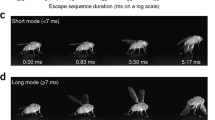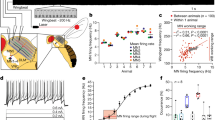Abstract
Visually evoked escape flight initiation in Drosophila, according to the accepted account, involves a rapid extension of the middle legs that propels the fly into the air while the wings are still folded. This description has remained unchallenged and is accounted for in terms of the activation of a simple neural circuit, the Giant fibre (GF) system. The accepted description of escape is however inconsistent with the sequence of events recorded when the GF system is stimulated. Specifically, previous electrophysiological recordings have shown that the wing depressor muscles are activated before the wings are in a position to be depressed because they have not yet been elevated. Here we show that the accepted behavioural description is wrong. Escape flight initiation actually begins with wing elevation. The current model of the GF system is revised to account for the actual sequence of events that occur when a fly escapes.




Similar content being viewed by others
Abbreviations
- DLMn:
-
Dorsal longitudinal flight motoneuron
- GF:
-
Giant fibre
- PSI:
-
Peripherally synapsing interneuron
- TTMn:
-
Tergotrochanteral muscle motoneuron
References
Allen MJ, Drummond JA, Moffat KG (1998) Development of the giant fibre neuron of Drosophila melanogaster. J Comp Neurol 397:519–531
Allen MJ, Godenschwege TA, Tanouye MA, Phelan P (2006) Making an escape: development and function of the Drosophila giant fibre system. Semin Cell Dev Biol 17:31–41
Bacon JP, Strausfeld NJ (1986) The dipteran ‘giant fibre’ pathway: neurons and signals. J Comp Physiol A 158:529–548
Dickinson MH, Tu MS (1997) The function of dipteran flight muscle. Comp Biochem Physiol 116A:223–238
Eaton RC (1984) Neural mechanisms of startle behaviour. Plenum Press, New York
Furshpan EJ, Potter DD (1959) Transmission at the giant motor synapses of the crayfish. J Physiol 145:289–325
Holmqvist MH (1994) A visually elicited escape response in the fly that does not use the giant fibre pathway. Vis neurosci 11:1149–1161
Levine J, Tracey D (1973) Structure and function of the giant motorneuron of Drosophila melanogaster. J Comp Physiol 87:213–235
Levine J (1974) Giant neuron input in mutant and wild type Drosophila. J Comp Physiol 93:265–285
Milde JJ, Strausfeld NJ (1990) Cluster organization and response characteristics of the giant fiber pathway of the blowfly Calliphora erythrocephala. J Comp Neurol 294:59–75
Nachtigall W, Wilson DM (1967) Neuro-muscular control of dipteran flight. J Exp Biol 47:77–97
Phelan P, Nakagawa M, Wilkin MB, Moffat KG, O’Kane CJ, Davies JA, Bacon JP (1996) Mutations in shaking-B prevent electrical synapse formation in the Drosophila giant fibre system. J Neurosci 16:1101–1113
Phelan P, Bacon JP, Davies JA, Stebbings LA, Todman MG (1998) Innexins: a family of invertebrate gap-junction proteins. Trends Genet 14:348–349
Thomas JB, Wyman RJ (1982) A mutation in Drosophila alters normal connectivity between two identified neurones. Nature 298:650–651
Thomas JB, Wyman RJ (1984) Mutations altering synaptic connectivity between identified neurons in Drosophila. J Neurosci 4:530–538
Trimarchi JR, Schneiderman AM (1993) Giant fibre activation of an intrinsic muscle in the mesothoracic leg of Drosophila melanogaster. J Exp Biol 177:149–167
Trimarchi JR, Schneiderman AM (1995a) Flight initiations in Drosophila melanogaster are mediated by several distinct motor patterns. J Comp Physiol A 176:355–364
Trimarchi JR, Schneiderman AM (1995b) Different neural pathways coordinate Drosophila flight initiations evoked by visual and olfactory stimuli. J Exp Biol 198:1099–1104
Trimarchi JR, Schneiderman AM (1995c) Initiation of flight in the unrestrained fly, Drosophila melanogaster. J Zool Lond 235:211–222
Wyman RJ, Thomas JB, Salkoff L, King DG (1984) The Drosophila giant fiber system. In: Eaton RC (ed) Neural mechanisms of startle behavior. Plenum, New York, pp 133–161
Acknowledgements
We thank the Rutherford Appleton Laboratory and the Engineering and Physical Sciences Research Council for the loan of the Kodak Motion Corder SR-Ultra camera used in this study. György Kemenes advised on the statistical analysis and Jane Davies and Jonathan Bacon provided helpful comments on the manuscript.
Author information
Authors and Affiliations
Corresponding author
Electronic supplementary material
Below are the link to the electronic supplementary materials.
Fig. S1
The approaching object stimulus. a The experimental set-up. The disc’s distance from the funnel when the two strains of fly initiated an escape response is also indicated. b The accelerating approach of the disk was plotted by filming five descents (each point is the mean of five observations). The curve was extended to calculate the mean time to collision (234.4 ms ± 3.9 SEM). The position of the descending disc when escape is initiated is also indicated. (GIF 29 kb)
Rights and permissions
About this article
Cite this article
Hammond, S., O’Shea, M. Escape flight initiation in the fly. J Comp Physiol A 193, 471–476 (2007). https://doi.org/10.1007/s00359-006-0203-9
Received:
Revised:
Accepted:
Published:
Issue Date:
DOI: https://doi.org/10.1007/s00359-006-0203-9




